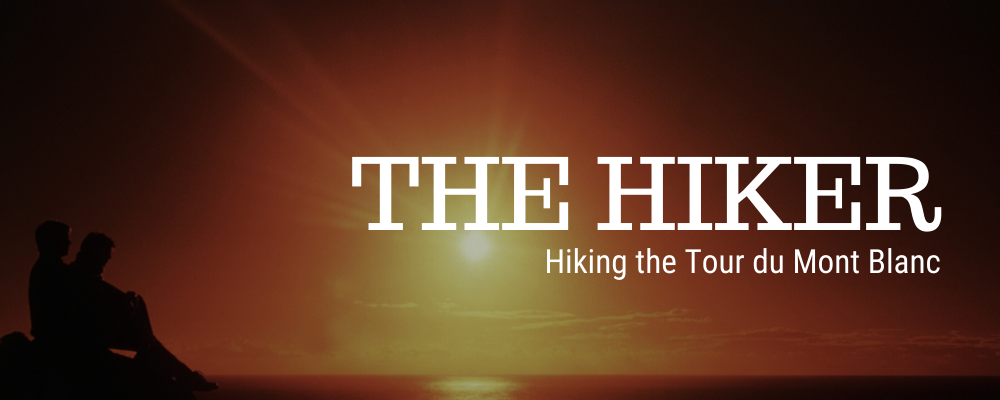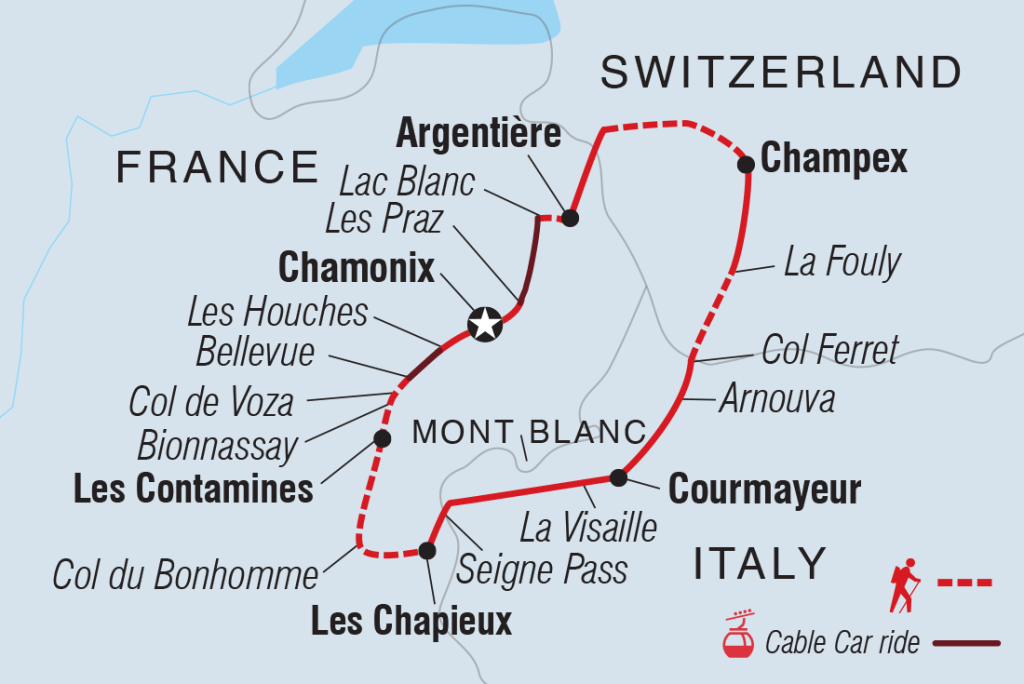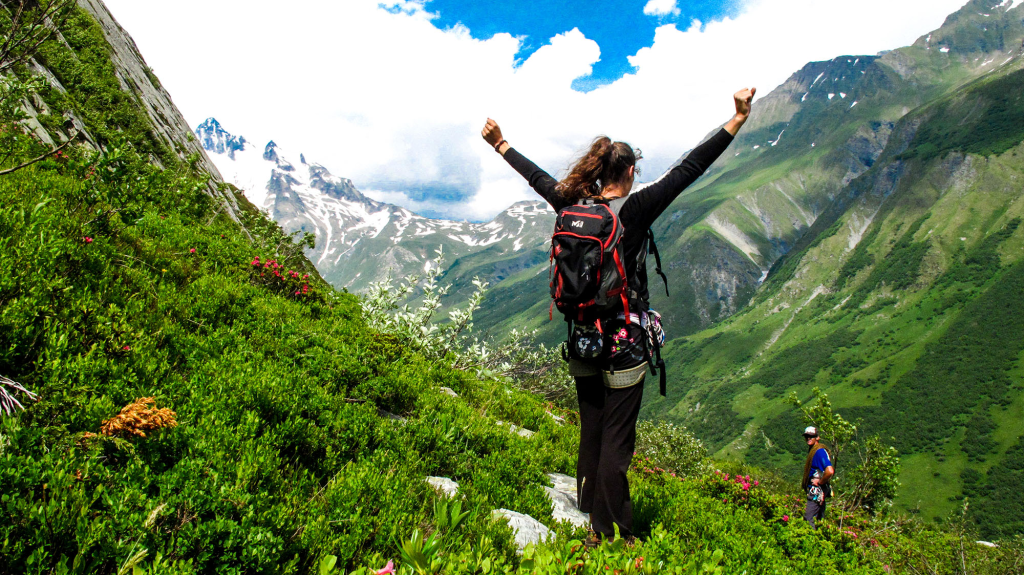
Embark on a breathtaking adventure with Hiking the Tour du Mont-Blanc, a journey that takes you through the heart of Europe’s majestic landscapes. Spanning 103 miles, this trek offers a unique blend of physical challenge and sensory delights. You’ll traverse the scenic terrains of France, Italy, and Switzerland, all while encircling the imposing Mont Blanc, standing at an impressive 15,771 feet.
This path isn’t just about endurance; it’s an experience of contrasting pleasures. Enjoy cozy accommodations in high-altitude huts, where fresh-baked treats await, and savor gourmet cuisine amid the rugged beauty of the Alps. With over 32,000 feet of ascending and descending, the trail tests your mettle, but it also rewards you with stunning alpine views, warm summer weather, and the thrill of navigating through unpredictable mountain storms.
This trek is more than a hike; it’s an unforgettable journey through some of Europe’s most breathtaking landscapes, offering both a test of physical endurance and a feast for the senses.
If you’re considering a trek on the Tour du Mont Blanc (TMB), you’re about to embark on a remarkable adventure through the stunning Alps. In this comprehensive guide, we’ll explore vital insights to help you prepare for this incredible journey, ensuring you have the knowledge and confidence needed to conquer this legendary trail.
Table of Contents
Key Points about Hiking the Tour du Mont Blanc
- The Tour du Mont Blanc is one of the oldest and most renowned hiking routes in the world.
- It encircles the Mont Blanc massif, spanning through France, Italy, and Switzerland.
- Expect breathtaking views, delicious cuisine, and authentic alpine experiences.
- The trail features snowy peaks, vast glaciers, wild rivers, and lush valleys.
- Most hikers take seven to 11 days to complete the route.
The Tour du Mont Blanc stands as one of the world’s oldest and most renowned hiking routes, weaving its way around the Mont Blanc massif and spanning across the borders of France, Italy, and Switzerland. Prepare to be captivated by breathtaking vistas, savor delectable local cuisine, and immerse yourself in authentic alpine experiences. The trail showcases snowy peaks, expansive glaciers, untamed rivers, and lush valleys, creating an unforgettable visual tapestry. Most adventurers dedicate seven to 11 days to complete the full route, savoring every moment of this exceptional journey.
An Expedition into Nature and History:

Hiking the Tour du Mont Blanc is not just a trek; it’s a voyage through history and nature. This ancient trail, older than most modern routes, has earned its reputation as one of the world’s most awe-inspiring hikes for good reason. As you follow its path, you’ll embark on a magnificent journey around the Mont Blanc massif, crossing the picturesque landscapes of France, Italy, and Switzerland. Prepare for spellbinding vistas, delectable local cuisine, and authentic alpine encounters. Each day of this adventure is filled with breathtaking beauty, from majestic snow-covered peaks to expansive glaciers, wild rivers, and lush valleys.
Given the trail’s length and the richness of experiences it offers, most adventurers dedicate seven to 11 days to fully immerse themselves in the Tour du Mont Blanc experience. So, get ready for a memorable journey that seamlessly blends history, nature, and adventure amidst the stunning backdrop of the Alps.
Starting and Ending point of the Tour du Mont Blanc.

Chamonix serves as the starting and ending point of the Tour du Mont Blanc. This bustling mountain town, nestled in the French Alps, offers a perfect launchpad for your adventure. Chamonix is renowned for its status as a popular ski resort and adventure sports hub. Located at the foot of Mont Blanc, it provides opportunities for skiing, snowboarding, climbing, and hiking. Additionally, it’s easily accessible from Geneva Airport (90km), offering various transport options.
How Challenging is the Tour du Mont Blanc about 1000 meters?
The Tour du Mont Blanc consistently ranks among the world’s top hiking trails due to its stunning scenery and remarkable flexibility. This trek stands out because of the numerous towns, villages, and transportation options along the route, allowing hikers to customize their journey. You can choose sections that match your skill level, adapt to changing weather conditions, suit your daily energy levels, or accommodate your available time.

Tthe Tour du Mont Blanc doesn’t demand prior hiking experience, but it’s no easy feat. It’s crucial to be in good physical shape for this adventure. Expect to cover daily distances ranging from 10 to 30 kilometers, depending on your chosen route, with an average daily ascent and descent of about 1000 meters. This routine continues for ten consecutive days.
To ensure you’re well-prepared, it’s advisable to undertake some practice hikes before taking on this trek. While the numbers may seem daunting, remember that the 170-kilometer journey and approximately 10,000 meters of ascent and descent are spread across multiple days. With determination, even beginners can tackle this challenge, and each day offers new experiences to motivate you toward the finish line. Soon, you’ll return to Chamonix, sharing stories and drinks with the locals, celebrating your remarkable achievement.
Your Perfect TMB Adventure Awaits:
The Tour du Mont Blanc beckons solo adventurers with the promise of a tailor-made trekking experience. Renowned for its breathtaking landscapes and diverse trails, the TMB accommodates hikers of all levels. Whether you’re a seasoned trekker seeking challenging routes or someone who prefers a leisurely pace, the TMB caters to your preferences. With well-marked paths winding through France, Italy, and Switzerland, you’ll traverse varied terrains, from lush valleys to alpine vistas. Accommodations along the route range from cozy village hotels to rustic mountain huts, ensuring both comfort and a taste of local culture.
Accommodations on the Tour du Mont Blanc offer a memorable and distinctive experience. Here’s what you can expect:
Mountain Hut Stays:
Several nights on the Tour du Mont Blanc will be spent in mountain huts, often becoming the most cherished memories of the journey. Alpine mountain huts provide a unique contrast to traditional accommodations, offering simplicity, warmth, and an authentic mountain atmosphere. Anticipate hearty, homemade meals that are as delicious as they are comforting. Your sleeping quarters will be cozy, and you’ll share stories with fellow trekkers after dinner. Bring earplugs just in case of snoring neighbors; it’s all part of the adventure. Mountain huts are usually located in remote areas, accessible only by foot, without Wi-Fi or phone signal, enhancing the sense of isolation. However, you’ll find some charging points for your devices to capture the breathtaking surroundings.
Alpine Hotels Option:
If the mountain hut experience isn’t your preference, Alpine hotels are available. Be prepared for short transfers to rejoin the trail each morning or at the end of your hiking day.
Guided Tours:
Trekking the Tour du Mont Blanc independently can be logistically challenging, with limited availability for hut accommodations. To ensure a hassle-free and authentic experience, consider joining a guided tour. Local guides are passionate about the region and well-versed in its hidden gems and detours.
Exploring the Tour du Mont Blanc legendary trek:

The Tour du Mont Blanc promises not only breathtaking landscapes but also a chance to immerse yourself in unique accommodation options, adding to the charm of this legendary trek. Expert assistance is available to tailor an experience that aligns perfectly with your needs and preferences. From selecting the right trails to choosing accommodations, guidance ensures every aspect of the trip is as fulfilling and enjoyable as possible. Embrace the adaptability and customization options of the TMB, and set off on one of the world’s most extraordinary hiking adventures, assured of support every step of the way.
Contemplating Your Travel Style: DIY, Self-Guided, or Guided?
If you relish planning and organizing your journey, the TMB is tailor-made for you. This self-guided adventure allows you to explore the charming towns in three different countries and select accommodations that align with your preferences.
Stephanie Lefferts, the tour manager at our company, Run the Alps, shares three valuable tips for DIY enthusiasts:
- Whenever possible, book directly through a hotel’s website. This often results in better rates, favorable terms, and supports family-run establishments.
- Consider choosing the half-board option, which includes dinner. After a day of trekking, the convenience of dining downstairs without the hassle of finding a restaurant can be a welcome relief.
- Early booking is key to securing your preferred accommodations.
Over the years, numerous planning resources have emerged for independent travelers. We recommend exploring our suggestions below and obtaining a copy of the renowned TMB guidebook, “Trekking the Tour du Mont Blanc” by Kev Reynolds. The most recent edition was released in 2020, and be sure to acquire the IGN Tour du Mont-Blanc map as a valuable navigation aid.
This information provides a comprehensive overview of lodging options and considerations for planning your adventure on the Tour du Mont Blanc.
Popularity and Seasons of the Tour du Mont-Blanc: Best Times for an Optimal Experience

As you traverse this legendary route, you’ll also immerse yourself in captivating history and rich local culture, enriching your adventure. With the allure of the Tour du Mont Blanc beckoning, there’s no reason to delay. Start planning your adventure for the upcoming summer season. Among all the Mont Blanc treks, this one stands as an unparalleled gem. Are you ready to embrace the challenge?
Best Time to Explore the Tour du Mont Blanc (TMB):
- Late June to September is the ideal period for TMB trekking.
- During this time, melting snow opens up the trail, offering comfortable weather.
- The TMB rewards with stunning natural beauty and cultural experiences.
Consider Peak Season: July and August:
- High activity and demand in peak summer months.
- Plan well in advance, expect higher costs, and limited availability.
- Many tour operators close bookings early due to the high demand.
Optimal Flexibility: Late June or Post-UTMB in August:
- Late June offers fewer crowds but watch out for snow on high passes.
- Equip yourself with hiking poles and microspikes for safety.
- Late August, post-UTMB race, provides a quieter experience.
Late Season Serenity in September:
- September offers snow-free paths, clear skies, and fewer crowds.
- Facilities remain open until mid-September, but prepare for cooler nights.
- Snowstorms are possible but less likely.
Booking Tips for Crowded Months:
- If you must travel in July or August, book accommodations a year in advance.
- Request packed lunches from your hotel to avoid lunchtime hut rushes.
- Crowds don’t diminish the TMB’s allure, and its beauty is worth sharing.
The late season in September is ideal for hiking the TMB. You’ll find snow-free paths, clear skies, and fewer crowds, making it a serene experience. Most facilities remain operational until mid-September, but prepare for cooler nights and the possibility of snowstorms.
Embarking on the Tour du Mont Blanc (TMB): An Achievable Challenge

The Tour du Mont Blanc, spanning 170 kilometers with significant elevation changes, may appear daunting, but it’s an attainable goal, even for those with limited hiking experience. Here’s what you need to know:
- Physical Fitness is Crucial: While prior hiking experience isn’t mandatory, being physically fit is essential. The TMB offers daily hikes ranging from 10 to 30 kilometers, with an average ascent and descent of 1000 meters. This routine continues over around ten days.
- Preparatory Hikes Help: Engaging in preparatory hikes can ensure you’re ready for the challenge.
- Divided Distance: Don’t be discouraged by the total distance and elevation changes. The TMB divides these challenges over several days, making it manageable for both avid hikers and determined beginners.
- Personal Satisfaction: Completing the TMB isn’t just about physical endurance. It’s about the immense personal satisfaction and achievement you’ll experience. Picture yourself in Chamonix, embracing local traditions, and reveling in the sense of accomplishment alongside fellow hikers.
The TMB promises not only a physical journey but also an enriching and rewarding adventure that you can aspire to conquer.
Strategies for Booking Your Tour du Mont Blanc Adventure
Organizing your Tour du Mont Blanc (TMB) excursion offers several options: planning it independently, hiring a guide, or using a tour operator. Each method requires early preparation. “Planning 9 months in advance is crucial, especially if you aim to stay at the most sought-after locations,” advises Troy Haines, the owner of Alpinehikers, a company specializing in guided and self-guided hikes on the TMB for over 20 years.
Organizing Your TMB Excursion:
- You have several options for organizing your Tour du Mont Blanc (TMB) hike: independent planning, hiring a guide, or using a tour operator.
- Early preparation is essential, especially if you want to secure accommodations at sought-after locations.
- Flexibility is an asset, including considering alternative dates, accommodation types (like dorms), and transportation options to nearby villages.
Tips for Independent Trip Planning:
- If planning your own TMB trip, particularly for summer, creativity may be required.
- Consider exploring neighboring villages for accommodations if traditional trail stops are fully booked.
- Services like Taxi Besson can help transport hikers to and from different trail points.
- Busy spots to watch out for include Les Chapieux in France, and La Fouly and Trient in Switzerland.
Discovering Quaint Villages off the Beaten Path:
- Alternative nearby towns like Bourg St. Maurice, Beaufort, Arêches, Finhaut, or Vallorcine can offer charming stays.
- Utilize transportation options, such as Swiss Post buses, to move ahead on the trail if your planned stop is full.
- Viewing these detours as mini-adventures can enhance your TMB experience and introduce you to unique villages.
Viewing these detours as mini-adventures can enrich your TMB experience, allowing you to discover quaint villages off the beaten path.
Hiking Safety Essentials:
Safety is paramount when hiking, and here are some essential tips to keep in mind:
Plan and Research:
- Thoroughly research the trail’s difficulty, distance, and elevation gain.
- Check weather forecasts and trail conditions.
- Share your hiking plans and return time with someone trustworthy.
Choose Appropriate Trails:
- Select trails matching your fitness level.
- Gradually increase difficulty as your skills improve.
Proper Gear and Clothing:
- Wear moisture-wicking clothing appropriate for the season.
- Invest in high-quality hiking boots.
- Carry essential gear, including a map, compass, GPS device, first aid kit, headlamp, and multi-tool.
- Dress in layers for changing weather.
Hydration and Nutrition:
- Carry an adequate supply of water.
- Pack nutritious snacks.
- Leave No Trace:
- Follow Leave No Trace principles.
- Respect wildlife and stay at a safe distance.
- Stay on marked trails and avoid shortcuts.
- Know Your Limits:
- Listen to your body and don’t push beyond your physical abilities.
- Weather Awareness:
- Be prepared for changing weather.
- Seek shelter during storms.
- Navigation Skills:
- Familiarize yourself with map reading and navigation tools.
- Group Hiking:
- Hike with a group or at least one companion.
- Stay close together.
- Wildlife Safety:
- Learn about local wildlife and how to safely encounter them.
- Carry wildlife deterrents if needed.
- Emergency Preparedness:
- Carry a whistle and know how to use it.
- Have a charged mobile phone with emergency numbers.
- Know basic first aid and wilderness survival.
- Respect Private Property:
- Stay on public land and get necessary permits.
- Sun Safety:
- Protect your skin from the sun.
- Trail Etiquette:
- Yield to hikers going uphill and be courteous.
- Keep noise levels down.
By following these hiking safety tips, you can minimize risks and make the most of your outdoor adventures while staying safe and responsible.
In Conclusion:
Embarking on the Tour du Mont Blanc is an adventure of a lifetime, offering a unique combination of stunning scenery, cultural richness, and gastronomic delights. Whether you’re an experienced trekker seeking challenges or a nature enthusiast looking for a leisurely pace, this legendary trek caters to all. From the bustling gateway of Chamonix to the majestic Mont Blanc massif and the captivating landscapes of France, Italy, and Switzerland, every step of the Tour du Mont Blanc is an unforgettable experience. So, gear up, prepare your backpack, and embrace the challenge of the Tour du Mont Blanc – your mountain adventure awaits!